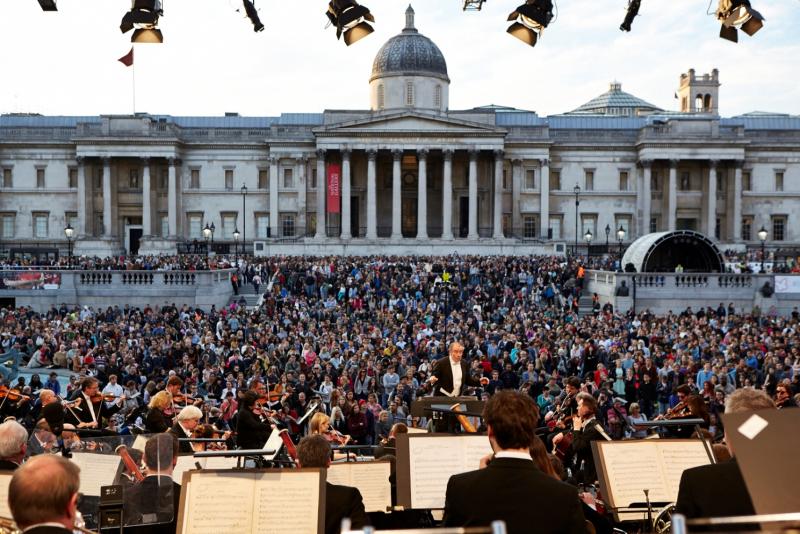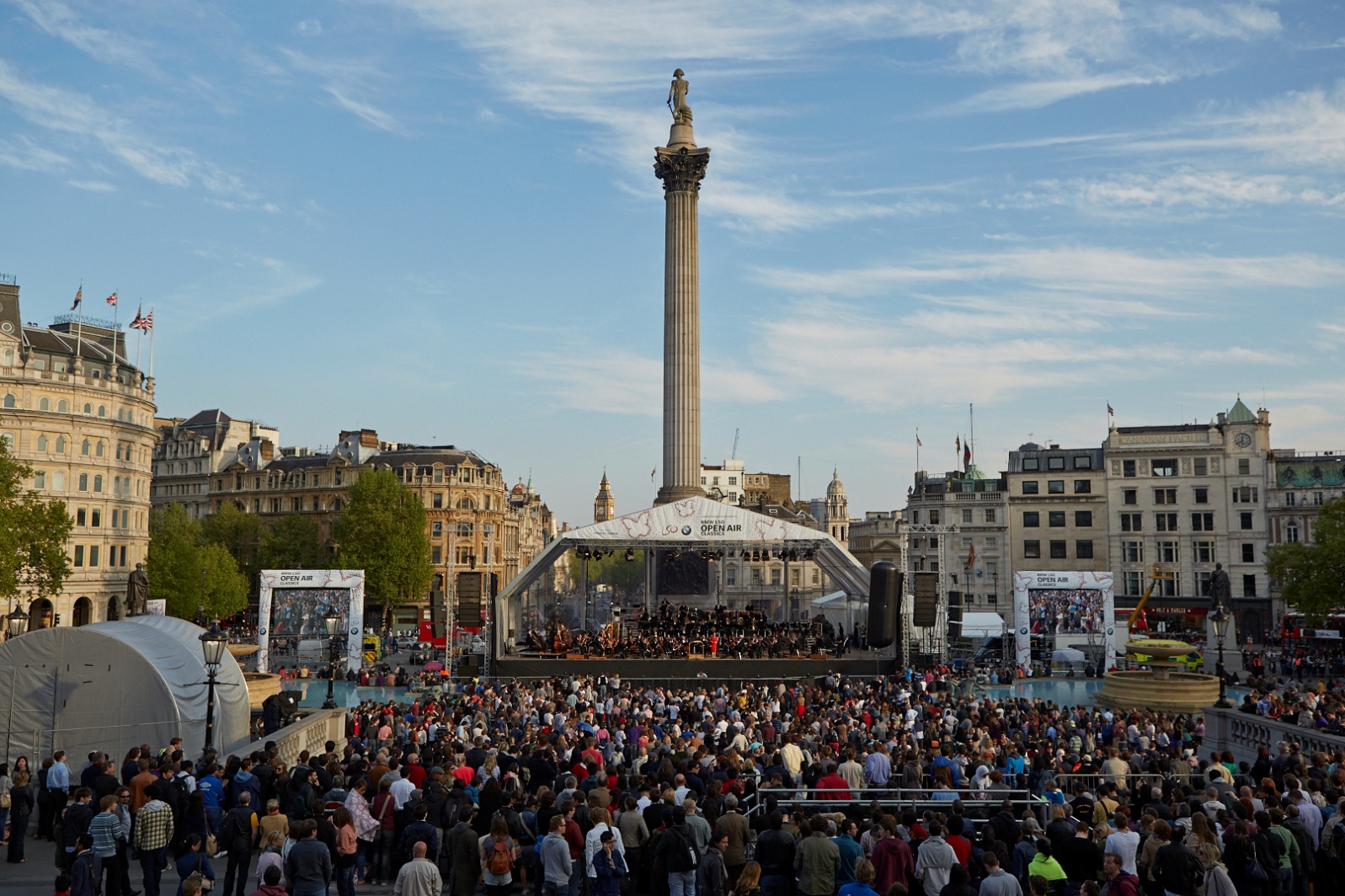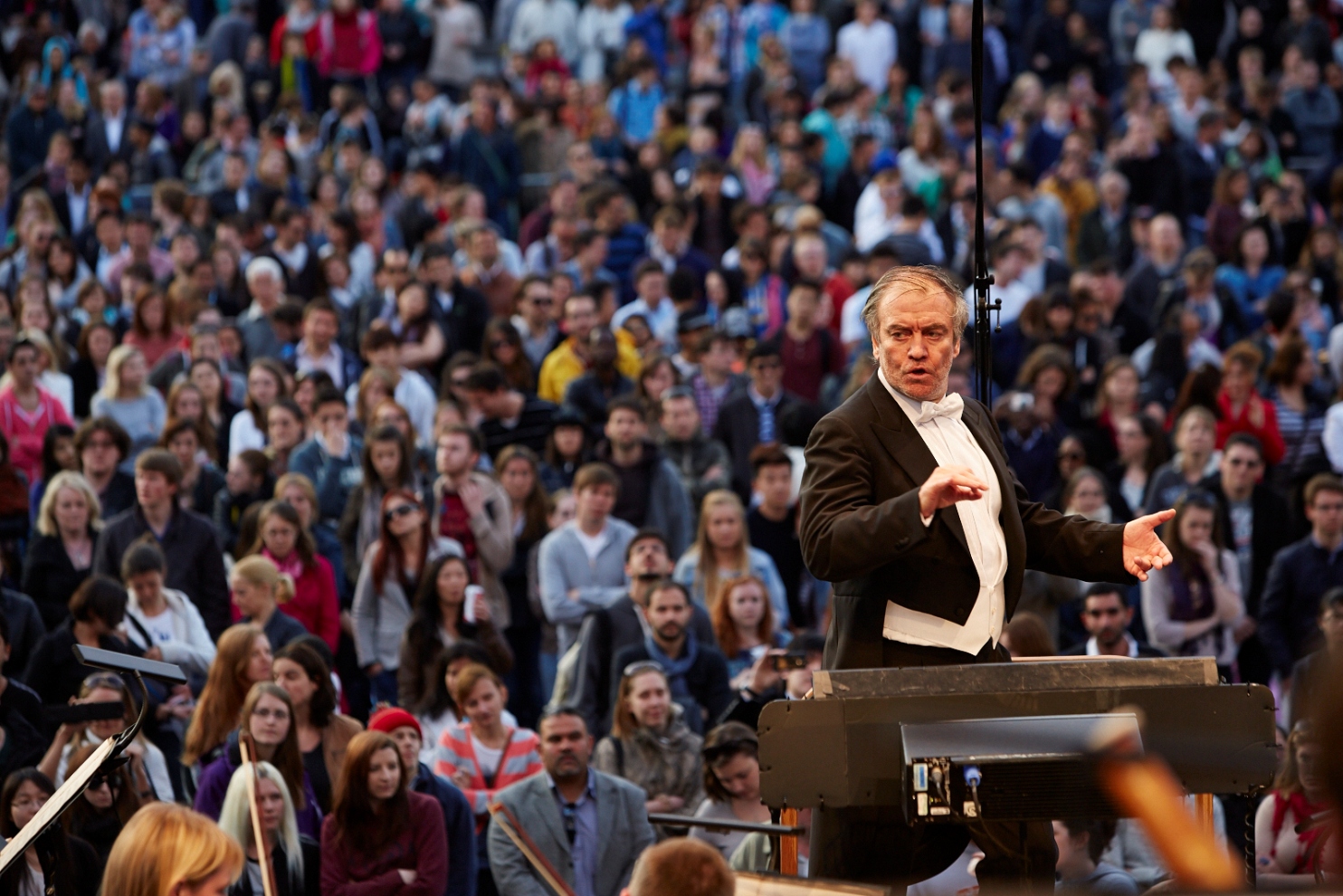London Symphony Orchestra, Gergiev, Trafalgar Square | reviews, news & interviews
London Symphony Orchestra, Gergiev, Trafalgar Square
London Symphony Orchestra, Gergiev, Trafalgar Square
Berlioz drowns out nationalism in a summer evening festival of unity

Down Whitehall, the English Defence League had been making ripples, and at 7.40pm some of its packs were still roaring round Trafalgar Square. At that moment, Berlioz’s March to the Scaffold from the Symphonie fantastique drowned them out in one big va t’en which you could have translated into a hundred languages.
For here was the music of a Frenchman conducted by a Russian, played by an orchestra of many nationalities to a packed-out crowd of many more and every creed, made up of adults, children, babies and dogs. As in last week’s horrific murder, for every minus, however gross, more than a couple of pluses resound louder about London life.
It was a truly democratic occasion: absolutely free, no seats, no special places for guests and press. Arriving just in time from inspecting Chagall windows in a Kent country church, I only just got in to sit on the ground to the far right – and this time I mean that literally – of the stage. This is the second year Valery Gergiev, the London Symphony Orchestra and its various educational wings have teamed up with BMW – OK, give them their due for what’s now become a Europe-wide al fresco phenomenon – to shake the foundations of Nelson’s Column and the National Gallery.

Last year it was Stravinsky’s The Rite of Spring; this year Berlioz rocked. The Symphonie fantastique took centre stage, flanked by the Overture Le corsaire to send off the opening fireworks and the Rakoczy March from The Damnation of Faust as an encore, trailing the LSO/Gergiev Berlioz season to come. Before the complete symphony, Gareth Glyn’s potted tour of the highlights gave Guildhall School players and young musicians from the 10 East London boroughs participating in the LSO On Track scheme a chance to play alongside their seniors. Comic segues and a jolly young oom-pah tuba player gave it a special kind of esprit, though the 15 minutes might have been better spent with presenter/educator Rachel Leach using the team to guide listeners through what they were about to hear (the little programmes handed out for free, though, did a good job).
There was a slight air of desperation about the singalong Leach conducted in the middle of the symphony. I’d wondered what on earth they were going to do about the near-silences of Berlioz’s central Scene in the Fields. In the end, Leach announced that the police sirens, helicopters and revving transport would have wrecked it. So instead collective woodwind played the cor anglais’s shepherd-calls (“Hello, how are you, how’s [sic] the sheep”) and we were supposed to bellow back the offstage oboe as “Hello, we’re fine, sheep good”. Later we were the thunderous answers to the lone piper.
Not, to put it mildly, the best substitute for musical romanticism’s high sublime. That might have worked in Kenwood or a country-house park. But I wonder about the wisdom of such an epic in such a space. Perhaps there was a chance missed to present the kind of first-class light music the LSO never get to feature in concert: Chabrier’s Joyeuse Marche, Massenet’s Meditation from Thais, ballet music by Delibes and Poulenc (and, off the French tack, Gergiev once conducted Eric Coates’s Knightsbridge March as a Prom encore).

Anyway, the hysterias of Berlioz's first movement, the frenzied climax of the waltz, the rollickings of the march and the witches’ orgy went down well enough, with lots of bottom-wiggling from the standees and dancey-dancies from the children. This is not a review of Gergiev’s interpretation; I only got the megaphoned sound of every string through the loudspeakers from far back on the right of the stage, though once I’d moved to the centre for the Witches’ Sabbath, the natural sound added to the amplified did give a sonic thrill and I could see how attentively the hardcore who’d got there first were taking it.
Litter removers came and went; orange-lit attendants loudly cleared the steps of incomers (admitted once some around the edge had left). It was all carried off in the best of spirits, though I have to say that the quirky highlight of the entire early evening for me was the novelty act at Embankment tube on the way back: a top-hat-and-tailed gentlemen sitting on an old transistor which belted golden oldies while he played the tuba part, fire belching on every note. Now that’s genius. Oh, and yes, the weather was perfect and the LSO ticked all the boxes in introducing hundreds, possibly thousands, to their first classical concert.
Explore topics
Share this article
The future of Arts Journalism
You can stop theartsdesk.com closing!
We urgently need financing to survive. Our fundraising drive has thus far raised £49,000 but we need to reach £100,000 or we will be forced to close. Please contribute here: https://gofund.me/c3f6033d
And if you can forward this information to anyone who might assist, we’d be grateful.

Subscribe to theartsdesk.com
Thank you for continuing to read our work on theartsdesk.com. For unlimited access to every article in its entirety, including our archive of more than 15,000 pieces, we're asking for £5 per month or £40 per year. We feel it's a very good deal, and hope you do too.
To take a subscription now simply click here.
And if you're looking for that extra gift for a friend or family member, why not treat them to a theartsdesk.com gift subscription?
more Classical music
 Kempf, Brno Philharmonic, Davies, Bridgewater Hall, Manchester review - European tradition meets American jazz
Bouncing Czechs enjoy their Gershwin and Brubeck alongside Janáček and Dvořák
Kempf, Brno Philharmonic, Davies, Bridgewater Hall, Manchester review - European tradition meets American jazz
Bouncing Czechs enjoy their Gershwin and Brubeck alongside Janáček and Dvořák
 Solomon, OAE, Butt, QEH review - daft Biblical whitewashing with great choruses
Even a top soprano and mezzo can’t make this Handel paean wholly convincing
Solomon, OAE, Butt, QEH review - daft Biblical whitewashing with great choruses
Even a top soprano and mezzo can’t make this Handel paean wholly convincing
 Two-Piano Gala, Kings Place review - shining constellations
London Piano Festival curators and illustrious friends entertain and enlighten
Two-Piano Gala, Kings Place review - shining constellations
London Piano Festival curators and illustrious friends entertain and enlighten
 Echo Vocal Ensemble, Latto, Union Chapel review - eclectic choral programme garlanded with dance
Beautiful singing at the heart of an imaginative and stylistically varied concert
Echo Vocal Ensemble, Latto, Union Chapel review - eclectic choral programme garlanded with dance
Beautiful singing at the heart of an imaginative and stylistically varied concert
 Scott, Irish Baroque Orchestra, Whelan, RIAM, Dublin review - towards a Mozart masterpiece
Characteristic joy and enlightenment from this team, but a valveless horn brings problems
Scott, Irish Baroque Orchestra, Whelan, RIAM, Dublin review - towards a Mozart masterpiece
Characteristic joy and enlightenment from this team, but a valveless horn brings problems
 Classical CDs: Voice flutes, flugelhorns and froth
Baroque sonatas, English orchestral music and an emotionally-charged vocal recital
Classical CDs: Voice flutes, flugelhorns and froth
Baroque sonatas, English orchestral music and an emotionally-charged vocal recital
 Kanneh-Mason, Britten Sinfonia, Shave, Milton Court - a grin and a big beaming smile
A pair of striking contemporary pieces alongside two old favourites
Kanneh-Mason, Britten Sinfonia, Shave, Milton Court - a grin and a big beaming smile
A pair of striking contemporary pieces alongside two old favourites
 theartsdesk at the New Ross Piano Festival - Finghin Collins’ musical rainbow
From revelatory Bach played with astounding maturity by a 22 year old to four-hand jazz
theartsdesk at the New Ross Piano Festival - Finghin Collins’ musical rainbow
From revelatory Bach played with astounding maturity by a 22 year old to four-hand jazz
 First Person: Manchester Camerata's Head of Artistic Planning Clara Marshall Cawley on questioning the status quo
Five days of free events with all sorts of audiences around Manchester starts tomorrow
First Person: Manchester Camerata's Head of Artistic Planning Clara Marshall Cawley on questioning the status quo
Five days of free events with all sorts of audiences around Manchester starts tomorrow
 Goldscheider, Brother Tree Sound, Kings Place review - music of hope from a young composer
Unusual combination of horn, strings and electronics makes for some intriguing listening
Goldscheider, Brother Tree Sound, Kings Place review - music of hope from a young composer
Unusual combination of horn, strings and electronics makes for some intriguing listening

Add comment